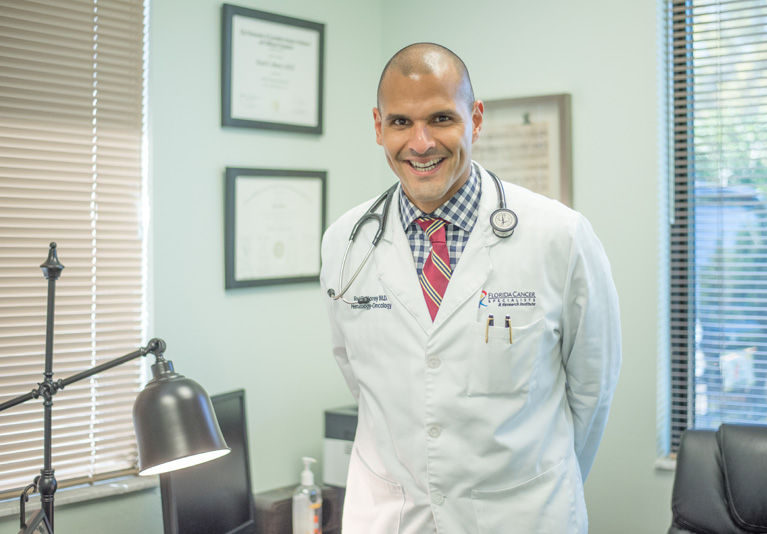
Lymphoma is one of the most common forms of cancer, and while its frequency is a negative, there is some good news about the disease.
“(It is) highly treatable,” says Dr. Raul Storey of the Florida Cancer Specialists and Research Institute.
There are two major types of lymphoma. Non-Hodgkin’s lymphoma, (NHL), which accounts for roughly 90 percent of all cases, and Hodgkin’s lymphoma which is responsible for the remaining 10 percent.
The focus here is NHL.
The American Cancer Society projects that some 72,580 new NHL cases will be diagnosed in this country this year and more than 20,000 Americans will die from the disease.
In Florida alone, ACS expects 5,370 new cases will be reported with almost 1,500 deaths.
“We don’t know what triggers it,” Storey says. “We do know about the risk factors, or the things that make someone more prone to develop the disease, but there are people who are exposed to those risk factors that never get it, and there are people who have never been exposed to those risk factors and they do get it.”
Storey – along with fellow Florida Cancer Center and Research Institute physician Dr. Noor Merchant – was recently mentioned in an interview with Dr. James Grichnik, director of the new $48 million Scully-Welsh cancer center, as one of the Vero Beach cancer specialists he’d “really love to have associated” with Scully-Welsh. It’s not hard to understand why.
Personable, articulate and laser-focused, Storey has a knack for making even a complex cancer such as NHL much more understandable.
According to New York’s Memorial Sloan Kettering Cancer Center, NHL starts in the body’s white blood cells or lymphocytes – immune-system cells responsible for helping fight infections.
They are present throughout the entire body through the lymphatic system which includes the lymph nodes, the bone marrow, the thymus, spleen and the tonsils as well as in the digestive tract.
NHL can cause those cells to grow abnormally and as they pass throughout the body they can begin forming tumors.
Unfortunately, non-Hodgkin’s lymphoma is difficult for the layman to detect; symptoms are often ambiguous, at best.
The American Cancer Society lists swollen lymph nodes in the neck, armpits or groin, unexplained weight loss, fever, weakness or fatigue and a feeling of fullness in the abdomen as potential signs.
Storey points out, however, that there could be multiple other causes for any of those symptoms, especially in people 65 and older – and that age group is the one most commonly affected by NHL.
“The majority of the time,” Storey continues, “having a swollen lymph node is caused by an infection.”
Still, he warns, if the patient’s primary care doctor treats that swollen node with antibiotics and it doesn’t improve – or gets worse – then it’s probably time to take the next step and get a biopsy.
Like all cancers, the earlier treatment begins, the better the chances for survival.
Today there are nearly 600,000 Americans whose NHL is either under control, in remission or gone entirely.
Still, the terminology many physicians use to explain NHL to their patients seems to be full of contradictions. The cancer is often categorized as being either “indolent” or “aggressive” yet the indolent strains are actually harder to treat than the aggressive types.
In fact, Merck Manuals, the world’s leading medical textbook, claims, “Indolent lymphomas are slowly progressive and while responsive to therapy they are not curable with standard approaches. Aggressive lymphomas are rapidly progressive but are responsive to therapy and often are curable.”
Storey says there are essentially five treatments he recommends most frequently and, perhaps surprisingly, the first is doing nothing.
The National Cancer Institute agrees. “If you don’t have symptoms,” says NCI, “you may not need treatment right away. This is called watchful waiting.”
If symptoms do appear and begin adversely affecting a patient’s lifestyle, Storey continues, chemotherapy, immunotherapy, radiation therapy and bone marrow transplants are all highly effective tools in the oncology tool belt.
Meanwhile, promising new technologies appear to be on the horizon.
As recently as March 11 of this year, the Los Angeles Times reported that biotech firm Kite Pharma has plans to completely revolutionize the treatment of NHL.
The Santa Monica, Calif., company is currently re-programing patients’ own lymphocytes to seek out and destroy any cancerous lymphoma cells they encounter within the immune system.
Swiss pharmaceutical giant Novartis and the Seattle-based Juno Therapeutics are developing similar new technologies and while rigorous testing by the Food and Drug Administration still lies ahead for all three, they could someday mark the beginning of the end of the sixth most common cancer in the United States.
Dr. Raul Storey is with Florida Cancer Specialists & Research Institute at 1880 37th Street, Suite 101 in Vero and 13060 U.S. Hwy. 1, Suite A in Sebastian. The Vero phone number is 772-567-2332. The number for the Sebastian office is 772-589-0879.



